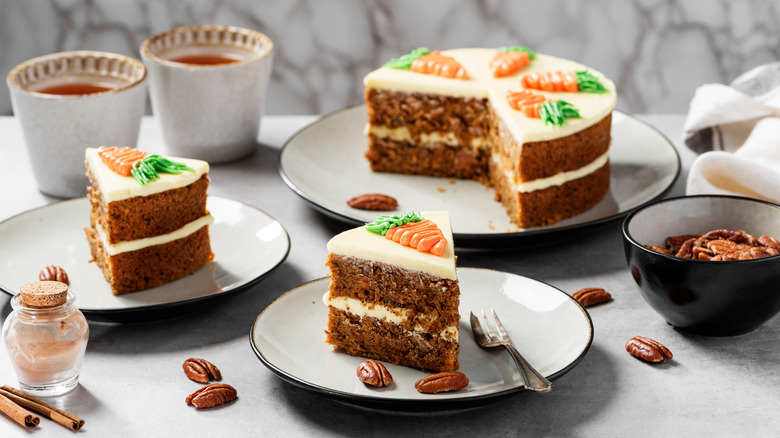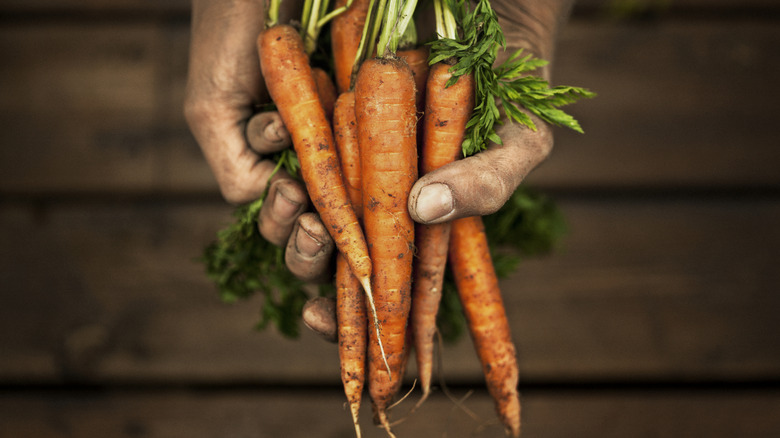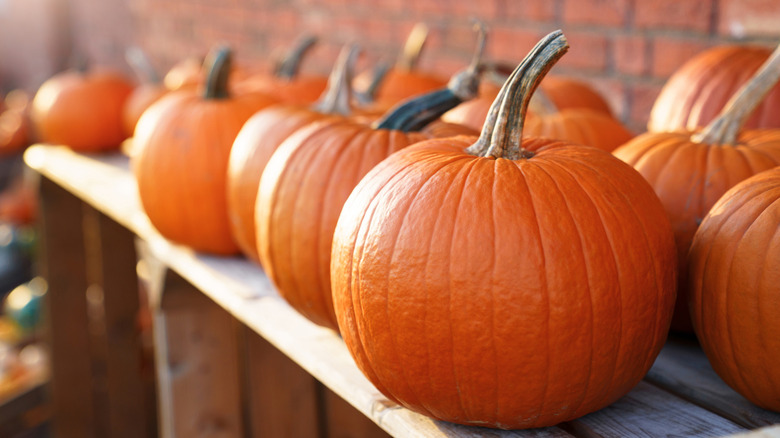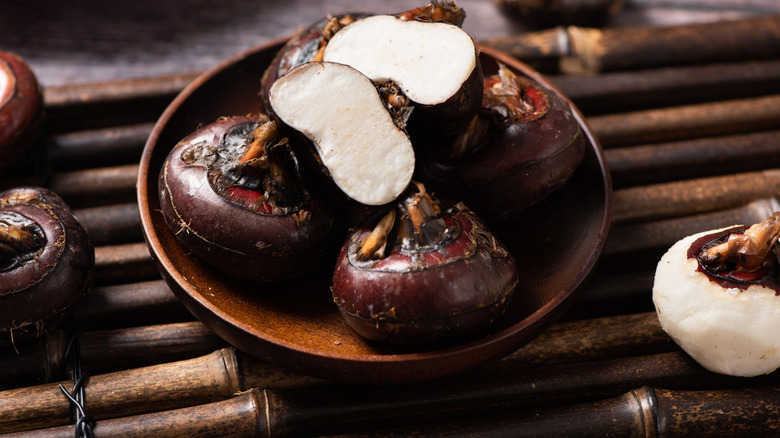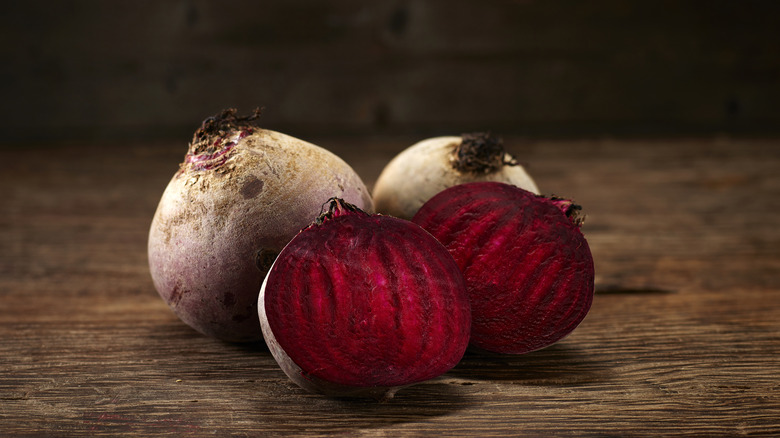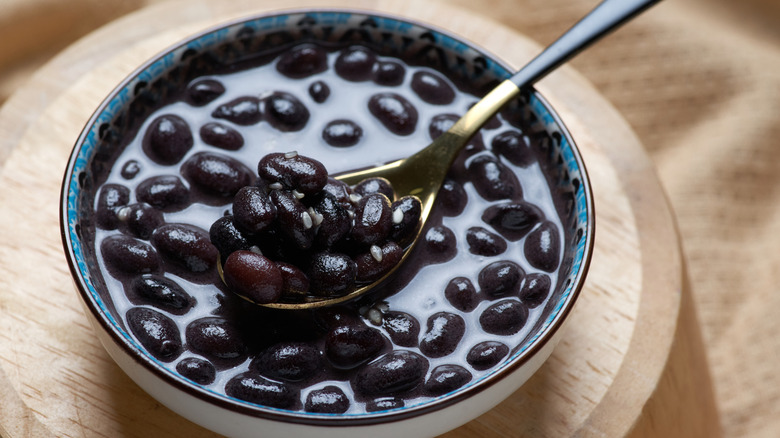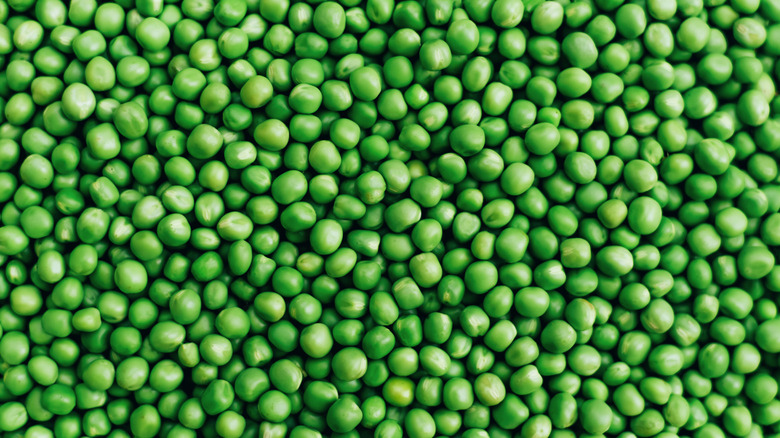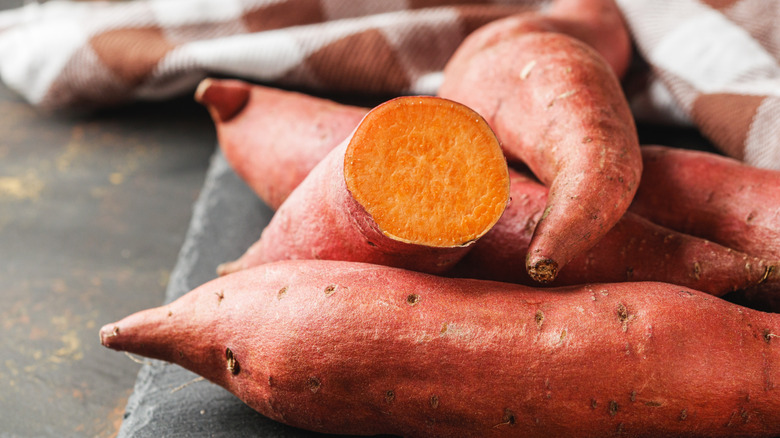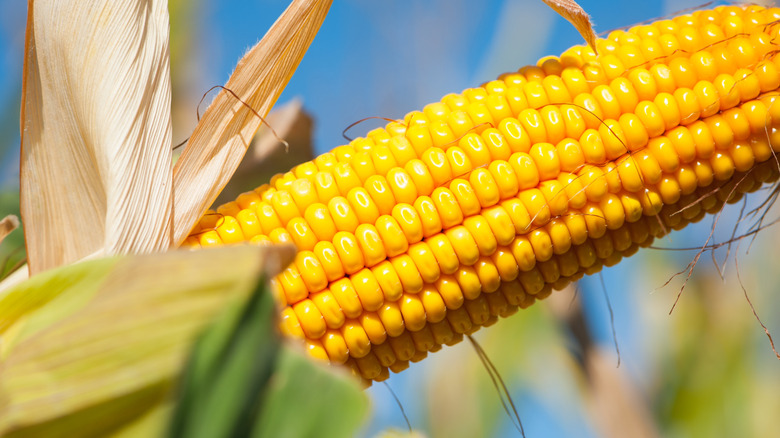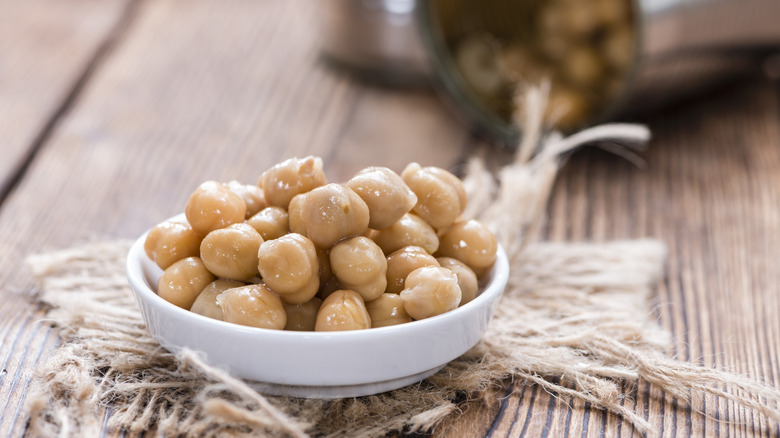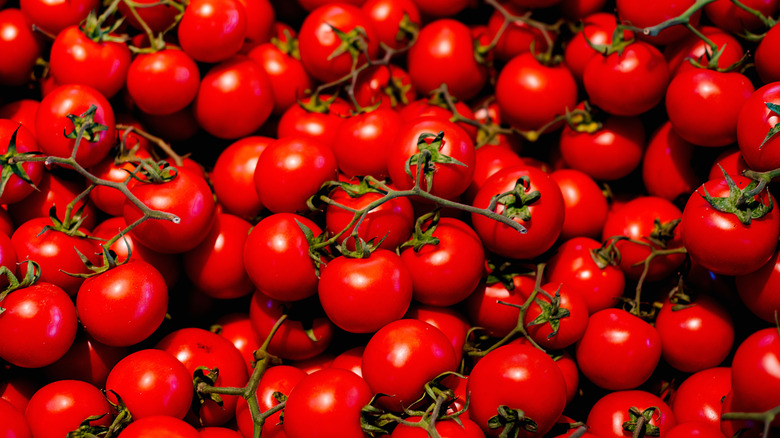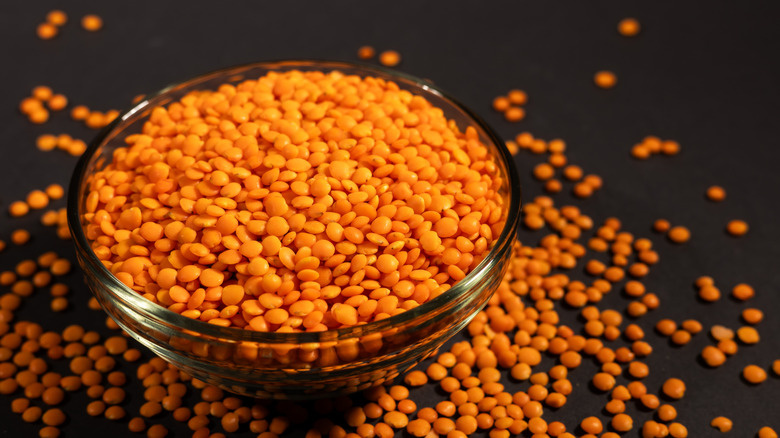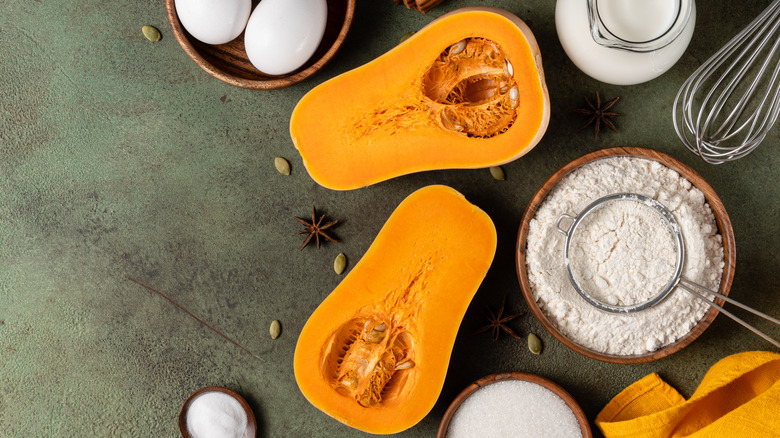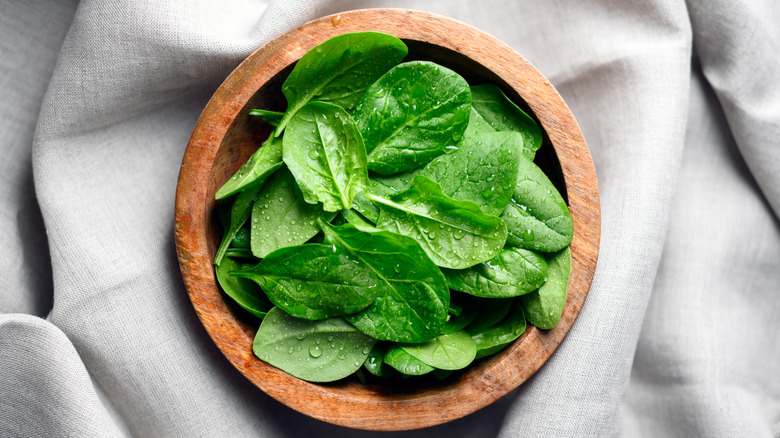13 Canned Vegetables That Make Delicious Cakes
When you're looking for a cake to bake that doesn't go over the top with indulgence, there are plenty of options. You could swap whole wheat flour for white flour, skip the icing, or use honey instead of sugar. Alternatively, you could get the best of both worlds by making a cake that is exactly as indulgent as you want it, but which incorporates an indisputably healthy element -– a vegetable. Considering how unappetizing they sound, vegetable cakes and sweet breads are surprisingly popular. Think of luscious, frosting-covered carrot cakes or lightly spiced zucchini bread. Neither of those would look out of place next to a layered vanilla cake or tin or brownies.
There are many plants that are botanically categorized as vegetables but which lend themselves to sweet recipes. Beets and corn, for example, are full of sugar, while chickpeas and garden peas have enough starch to provide a deliciously dense, cakey texture to baked goods without imposing too much flavor. Then, there's spinach, which is almost exclusively found in savory dishes but which, it turns out, has very little taste in sweet recipes. So, the next time you're craving a home-baked cake, try adding a vegetable and see how deliciously indulgent it can be. Better yet, we've rounded up the vegetables you can use right out of the can instead of having to spend time slicing, peeling, and grating.
1. Carrots
No list of vegetable-based cakes would be complete without carrot cake. Yet, it's easy to forget to include it because carrots don't really seem like a veggie when you're digging into the fluffy, sugary layers of cakey deliciousness. There's a reason we have recipes for carrot cake pancakes, carrot cake cinnamon rolls, carrot cake baked donuts, and multiple options for carrot cake itself -– the formula just works.
Most carrot cake recipes call for shredded or grated carrots, but you can easily turn canned carrots into carrot cake, too. In fact, there are many reasons why you might not want to use raw carrots. Grating them takes a long time. It's dangerous (shredded knuckles are part of the gig). And what if you desperately want carrot cake, but don't actually have any carrots in the fridge? If any of these reasons ring true for you, forget about the fresh carrots and use a can instead. Canned carrots still have their vibrant color and sweet flavor, but you won't be left with bloody fingers.
If you plan to use this option, make sure to drain the carrots first. Most canned veggies are stored in water, and you don't want to add excessive moisture to your cake and upset the delicate ratio of ingredients. Once they have been drained, blend them into the wet ingredients with an immersion blender or food processor. If you want to mimic the texture of grated carrots, toss in a handful of shredded coconut.
2. Pumpkin
Another classic of the vegetable cake genre, pumpkin cake (and bread! And muffins!) is a must-try for anyone who loves fall flavors. Rather than merely being an inspiration for a spice mix, pumpkin is a winter squash that is usually found in cans rather than as a fresh item of produce. This is a relief for anyone who wants to avoid the tedious, exhausting working peeling, slicing, and cooking this notoriously tough-skinned ingredient, whether you're planning to roast it or add it to a sweet baked treat.
You can buy canned pumpkin in multiple formulations. Our 3-ingredient marshmallow pumpkin cake and pumpkin cream cheese sheet cake call for pumpkin pie mix, which already contains sugar and spices, while our pumpkin cranberry cake and pumpkin coffee cake call for regular, unsweetened, unspiced pumpkin purée. Neither option is inherently superior (though you may have a preference based on the brand). The main thing to keep in mind is which one you're using and which one the recipe calls for in order to cut back on the sugar or increase it if necessary.
If you are planning to start from scratch and use fresh pumpkins, you might be tempted to hit two birds with one stone and repurpose your Halloween Jack-O-Lantern. But be warned: carving pumpkins do not make the best food. They are grown to be decorations, not ingredients, and as a result, tend to have a mealy texture and bland flavor.
3. Water chestnuts
Despite their name, water chestnuts are not nuts, but rootlike vegetables that grow underwater. As a tuber, they are more closely-related to potatoes than pistachios, but were named because of their resemblance to chestnuts. They are extremely popular in Chinese cuisine, appearing regularly alongside other vegetables in savory recipes, such as stir fries. (You can try them for yourself with our easy moo goo gai pan recipe). However, as with many other vegetables, water chestnuts also have a sweet application.
Water chestnut cake (called "ma tai go" in Cantonese) is a popular dim sum recipe that is as delicious as it is visually striking. It doesn't have a classic bread-like texture, but a glassy, gelatinous one with crunchy pieces of water chestnuts suspended inside. It is often found in Hong Kong celebrations for New Year, but you can make it any time the craving strikes.
To make water chestnut cake, you need water chestnut flour (which you can find online and at many Asian markets), as well as canned water chestnuts, water, and sugar. The flour and water are whisked to form a thin batter, then mixed into a sugar syrup. Once you've added pieces of water chestnuts and allowed the mixture to thicken, it is steamed in a pan and served in small squares.
4. Beets
Beets are packed with sugar. In fact, they are so sweet that they account for 55% of domestically produced sugar, compared to only 45% from sugarcane (per the USDA). However, sugar beets are different from the red beets you find at the grocery store. Where sugar beets are about 18% sugar, red beets are about 7% sugar. This precludes them from being the preferred precursor to refined sugar, but it still makes them sweeter than strawberries and equally sweet as grapefruit. They are also full of health benefits, including antioxidants, which help fight oxidative damage, and nitrates, which studies have shown help with cardiovascular health.
Of all the amazing ways to cook beets, cakes are right at the top. Like carrots, they provide a hint of sugar and a tinge of vibrant color. They also have a sweet, earthy flavor that is more akin to sweet potatoes than other vegetable options like legumes. Beets are perfect for chocolate cake, bringing out the richness of the cocoa powder while adding moisture. They can also be used as a natural option for red velvet cake if you'd rather not use synthetic food coloring.
5. Black beans
Adding black beans to cake is a tough sell until you've tried the results. Adding sweet ingredients like carrots and beets are one thing, but adding one of the starring features of chili and burritos? No, thank you. But try this for yourself and you will likely be pleasantly surprised at how seamlessly they blend with the other ingredients to produce a rich, indulgent dessert.
Black beans are most commonly found in gluten-free cake recipes because they provide a texture that mimics wheat flour. Standard gluten-free flour options are plagued with imperfections. Either they produce a gluey texture or a crumbly one. In most cases, they barely rise. Beans are the perfect alternative because they provide a fudgy texture without the gumminess. Full of fiber and protein, they also offer a hefty dose of nutrients. Their richness and moisture can even replace the dairy in most recipes. If you only have black beans that contain sodium, you can still use them in your cake recipe as long as you cut out any additional salt. Just make sure they are otherwise unseasoned. You don't want a garlic and oregano-flavored chocolate cake.
Most sweet recipes that call for beans are chocolate-based (like our simple black bean brownie recipe). This is partly due to the fudgy texture that the beans provide, but it also helps mask any hint of bean flavor. Though there's no harm in experimenting with other options, sticking to intensely-flavored cakes is likely to yield the best results.
6. Peas
When you think of decadent layer cakes covered in luscious frosting, chances are that green peas aren't on your mind. Why would you add a classic vegetable side dish to a dessert? It isn't just for nutritional value. Peas are full of natural sweetness. In fact, they are even sweeter than some fruits. At 5.7 grams of sugar per 100 grams, peas are sweeter than raspberries, and strawberries. They are also packed with protein and fiber. Just one cup of them contains 16% of the recommended daily intake of protein and 30% of the recommended daily intake of fiber. Hiding them in a sugary cake is one of the sneakiest ways of getting your five a day.
Aside from their nutritional profile and the bright color they provide, peas offer textural benefits. When blended into a purée with the rest of the ingredients, they give a light, moist structure like puréed pumpkin, but offer an even richer texture because of their high starch content (around 30% compared to less than 7% in pumpkin). Plus, when combined with flavorings like vanilla and citrus, all traces of vegetable flavor disappear.
7. Sweet Potatoes
Sweet potatoes are superseded by pumpkin when it comes to cakes. Orange, sugary, and earthy, they are similar, but there are several reasons why you might prefer to use sweet potatoes when given the choice. For one thing, they are actually sweeter. 100 grams of sweet potato contains more than 4 grams of sugar compared to only 2.8 in pumpkin. They also contain much more starch than pumpkins (up to 80%, compared to around 7% in pumpkins), which provides structure and creaminess in addition to all the moisture they bring.
Sweet potato cake is a staple of Southern baking. When combined with spices and heaped with cream cheese frosting, its decadence is tough to beat. If you're using canned sweet potatoes, make sure to drain them well before puréeing them to avoid excessive moisture. You may also find that grocery stores carry canned yams rather than canned sweet potatoes. From a botanical standpoint, yams are actually white-fleshed and much less sweet. However, "yam" has been a colloquial word for sweet potatoes in the U.S. for centuries. So, as long as the product you're getting is orange, you can assume that they're sweet potatoes.
8. Corn
You've heard of cornbread, but if you haven't tried corn cake, you're missing out on the true potential of this delightfully sweet vegetable. For an ingredient that is packed with so much sugar, it's remarkable that it isn't used in desserts more often. 100 grams of corn contains more than 6 grams of sugar, making it sweeter than pumpkin and sweet potato and about as sweet as red beets. In fact, corn never really comes across as a savory element, even in savory dishes. Most of us use it as a sweet accent, a burst of sugary moisture in salty stir fries and soups. Build a cake around it and you get to enjoy this sweetness in all its glory.
There are many ways to use corn in cake. In Brazil, bolo de milho (corn cake) is a popular treat found across the country and is made by blending canned corn with coconut milk, sugar, and eggs, and combining them with flour and baking powder. The result is a dense, moist cake without icing that is the perfect accompaniment for an afternoon coffee. If you want something even more dessert-like, you can go all-out and make a corn layer cake, blending corn kernels with the wet ingredients to produce a creamy consistency. You can even add blended corn to the icing.
9. Chickpeas
Stand aside, hummus. There's a new application for chickpeas in town. This starchy legume is a favorite protein alternative for vegetarians and vegans, but it can be just as useful for bakers looking for a gluten-free ingredient that doesn't have the same gluey, rubbery pitfalls as starchy gluten-free flour. Instead, it offers a fudgy texture full of structure and moisture, an elusive combination.
Anyone who has experience with cooking chickpeas knows that they don't have much flavor. While this can be a liability when you're using them as a main ingredient in savory recipes, it's a benefit when you're trying to hide them in sweet recipes. Whether you're making a chocolate cake, a spice cake, or a cake with fruit, the garbanzo beans will tactfully disappear into the background. Unlike other legumes such as black beans and green peas, chickpeas have the additional benefit of a neutral tan color, making them even more discreet than other vegetable options. Just make sure to drain and purée them before adding them to a cake recipe.
10. Tomatoes
It has been widely publicized that tomatoes are not actually a vegetable but a fruit. However, given the fact we tend to associate vegetables with all things savory and fruit with all things sweet, they masquerade as vegetables most of the time. That is, until you put them in a cake.
Believe it or not, tomato cake used to be extremely popular. To make things even more strange, it wasn't plain, raw tomatoes that the recipes called for -– it was Campbell's tomato soup. In the early 20th century, leaveners like baking powder and baking soda were not readily available, so bakers had to use ingredients that were acidic in order to produce the bubbles that make quick breads and cakes rise. Buttermilk was a popular choice, but around the Great Depression when budgets were tight, Americans had to turn to their own ingenuity to get the job done. Campbell's tomato soup was one of the most popular alternatives. Tomatoes are acidic, and since the soup was a creamy purée, it added both a leavening agent and moisture to the recipe. Forty years later, tomato soup cake was a favorite recipe of the poet Sylvia Plath.
Of course, if you'd rather use plain old tomatoes, you can. But the novelty (and convenience) of using canned soup is worth trying at least once. Who knows? It might end up being your new favorite cake flavor.
11. Lentils
By now, you will probably have gathered that pretty much any starchy legume can be used in cake, and yes, lentils can too. For fans of Indian food, lentils are probably most well-known as the primary ingredient in dhal. These creamy stews are made by slow cooking the legume until it melts like butter in your mouth, and this ability to take on a velvety texture is what makes the ingredient so well-suited to cakes, too.
Like chickpeas and black beans, lentils are full of starch, making them the perfect addition if you want moisture and structure. They are also packed with protein. One cup of cooked lentils contains 18 grams, which is a whopping 36% of the recommended daily intake. Lentils aren't just for gluten-free cakes, either. In fact, most recipes for cakes that include the legume also call for flour. This makes their presence even more subtle. Instead of having a decent gluten-free, dairy-free cake, you'll simply end up with a deliciously moist cake that contains a secret ingredient that no one else will be able to identify.
12. Butternut squash
Like sweet potatoes, butternut squash is often overlooked in favor of pumpkin. As another starchy orange winter squash, butternut squash is even more similar to pumpkin than potatoes are, but there are reasons to incorporate it into cooking and baking more often. For one thing, butternut squash has more calories and carbohydrates than pumpkin, signaling that it is starchier and therefore slightly better at producing a creamy texture. In this respect, it is more of a middle ground between pumpkin and the much starchier option of sweet potatoes.
Ultimately, whether you use pumpkin or butternut squash will likely come down to availability more than their slight differences in flavor and nutrition. Because they are so similar, you can swap them for each other in any cake recipe, as long as you account for whether they are pre-sweetened. If you are using one of these options for the moisture and texture it offers rather than for its color, butternut squash has a more pale hue than pumpkin, making its presence more subtle.
13. Spinach
Spinach can be a tough sell for people in savory dishes, so it's bound to be even harder to sell in desserts. But trust us on this one: you won't taste the spinach and the cake will be an absolute show-stopper. Love it or loathe it, spinach has one of the most vibrant colors in the plant kingdom, and when you add it to cake, the results are striking. Meanwhile, the flavor is not. In fact, spinach is so green that you only need to use a small amount to make a difference. If you want to make a pistachio cake that is truly green as opposed to tan with a vague tinge of olive, spinach is the answer.
You don't have to take our word for it, either. None other than Claude Monet is rumored to have adored spinach in his cakes. In fact, the father of Impressionist painting wrote a cookbook in which he included a recipe for gâteau vert-vert (green-green cake), a breezy, summery concoction flavored with kirsch, pistachio, and lemon, with a spinach purée used for color.
